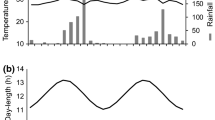Abstract
Principal components analysis of 7 size and shape variables measured on 154 modern fruit bodies of Betula species and hybrids shows that B. pubescens and B. nana can be distinguished from each other on the basis of their fruit bodies, and that B. pubescens ssp. tortuosa and hybrids either fall within the range of B. pubescens or have an intermediate position on PCA axes 1 and 2. Passive positioning on the modern PCA axes of fossil fruit bodies from late-glacial sediments at Eigebakken, south-west Norway, shows that only B. nana was locally present in the Allerød. This contradicts earlier inferences from pollen analyses alone of birch woodland development in the Allerød in south-west Norway. There is no macrofossil evidence for tree-birches in the Allerød near Eigebakken. The relatively large amounts of Betula pollen, including B. pubescens, at Eigebakken are thus probably derived by long-distance transport from tree-birches in Denmark, south Sweden, and Britain, whose presence is proved there by macrofossils. Consequently, earlier estimates of mean July temperature during the Allerød in southwestern Norway should be reduced to around 7.5–10°C. In contrast, the PCA shows that fruit bodies from Holocene sediments at Eigebakken and at Kråkenes, western Norway, are mostly derived from B. pubescens. Birch trees were able to spread quickly and effectively across Norway in the early Holocene.
Similar content being viewed by others
References
Andersen ST (1980) Early and Late Weichselian chronology and birch assemblages in Denmark. Boreas 9: 53–69
Bennike O, Jensen JB (1995) Near-shore Baltic Ice Lake deposits in Fakse bugt, southeast Denmark. Boreas 24: 185–195
Berglund BE, Digerfeldt G (1970) A palaeoecological study of the Late-Glacial lake at Torreberga, Scania, South Sweden. Oikos 21: 98–128
Bialobrzeska M, Truchanowiczówna J (1960) The variability of shape of fruits and scales of the European birches (Betula L.) and their determination in fossil materials. Monogr Bot (Warszawa) 9(2): 1–93
Birks HH (1993) The importance of plant macrofossils in lateglacial climatic reconstructions: an example from western Norway. Quat Sci Rev 12: 719–726
Birks HH (1994) Late-glacial vegetational ecotones and climatic patterns in Western Norway. Veget Hist Archaeobot 3: 107–119
Braak CJF ter (1987) Ordination. In: Jongman RHG, ter Braak CJF, van Tongeren OFR (eds) Data Analysis in Community and Landscape Ecology. Pudoc, Wageningen, pp 91–173
Braak CJF ter (1988) CANOCO — a FORTRAN program for canonical community ordination by [partial] [detrended] [canonical] correspondence analysis, principal components analysis and redundancy analysis (version 2.1). Agricultural Mathematics Group, Report LWA-88-02, Wageningen
Braak CJF ter (1990) Update notes: CANOCO version 3.10. Agricultural Mathematics Group, WageningenGodwin H (1975) History of the British flora, 2nd edn. Cambridge University Press, Cambridge
Hicks S (1986) Modern pollen deposition records from Kuusamo, Finland. II. The establishment of pollen: vegetation analogues. Grana 25: 183–204
Jensen HA (1985) Catalogue of late- and post-glacial macrofossils of Spermatophyta from Denmark, Schleswig, Scania, Halland, and Blekinge dated 13,000 B.P. to 1536 A.D. Dan Geol Unders, Series A, 6: 1–95
Jentys-Szaferowa J (1949–1951) Analysis of the collective species Betula alba L. on the basis of leaf measurement. Parts I–III. Bull Acad Pol Sci Lettr Krakow 1949 (7–10): 175–214; 1950 (1–3): 1–63; 1951 (1–2): 1–40
Jentys-Szaferowa J (1959) A graphical method of comparing the shapes of plants. Rev Pol Acad Sci 4: 9–38
Knaap WO van der (1987) Long-distance transported pollen and spores on Spitsbergen and Jan Mayen. Pollen Spores 24: 449–453 Liedberg Jönsson B (1988) The late Weichselian macrofossil flora in western Skåne, southern Sweden. Lundqua Thesis 24: 80 pp
Mamakova K (1968) Lille Bukken and Lerøy-two pollen diagrams from western Norway. Årbok Univ Bergen, Mat Naturv Ser 4: 1–42
Odland A (1996) Differences in the vertical distribution pattern of Betula pubescens in Norway and its ecological significance. Paläoklimaforschung 20: 44–59
Paus A (1989) Late Weichselian vegetation, climate and floral migration at Eigebakken, South Rogaland, southwestern Norway. Rev Palaeobot Pal 61: 177–203
Paus A (1995) The Late Weichselian and early Holocene history of tree birch in south Norway and the Bølling Betula time-lag in northwest Europe. Rev Palaeobot Pal 85: 243–262
Pennington W (1981) The representation of Betula in the Late Devensian deposits of Windermere, England. Striae 14: 83–87
Smilauer P (1992) CanoDraw 3. Microcomputer Power, Ithaca, New York
Tutin TG et al. (1993) Flora Europaea, Vol. 1, 2nd edn. Cambridge University Press, Cambridge
Wasylikova K (1964) Vegetation and climate of the Late-Glacial in central Poland based on investigations made at Witów near Leczyca. Biuletyn Periglacjalny 13: 261–417
Author information
Authors and Affiliations
Rights and permissions
About this article
Cite this article
van Dinter, M., Birks, H.H. Distinguishing fossil Betula nana and B. pubescens using their wingless fruits: implications for the late-glacial vegetational history of western Norway. Veget Hist Archaebot 5, 229–240 (1996). https://doi.org/10.1007/BF00217500
Received:
Accepted:
Issue Date:
DOI: https://doi.org/10.1007/BF00217500




